Ever wondered how accurate the wind speed readings can be?
Anemometers, the unsung heroes in weather observation and various other fields, provide critical data by measuring wind speed and sometimes direction. Whether you’re a meteorologist, an HVAC professional, a researcher, or an outdoor enthusiast, an anemometer is an indispensable tool.
But with a plethora of designs ranging from simple mechanical cup anemometers to advanced ultrasonic models, how do you pick the right one?
Well, we’ll be going over:
- What are the key considerations when choosing an anemometer for different applications like meteorology or HVAC?
- How do the various types of anemometers, like mechanical and ultrasonic, differ in functionality and suitability for specific environments?
- Which anemometer models are currently leading the market in terms of precision, durability, and user-friendly features?
An anemometer is not just a tool but a gateway to understanding and harnessing the power of wind.
Let’s dive in.
Top Anemometers in 2024
- Wintact Wind Pal – Top Pick
- AOPUTTRIVER Handheld Anemometer
- Protmex Wind Gauge
- AcuRite Notos 3-in-1 Sensor
- Invicta 13″ Anemometer
I’ve extensively researched and tested various anemometers to bring you this comprehensive list. Understanding wind speed is crucial for many professionals and hobbyists, from drone pilots to HVAC technicians. The devices in this roundup represent the pinnacle of precision, durability, and user-friendliness in the current market. My goal is to help you find an anemometer that not only fits your specific needs but also offers reliability and value. Whether you’re looking for a handheld model or a more sophisticated station, the following selection is sure to include the best anemometer for your endeavors.
Wintact Wind Pal
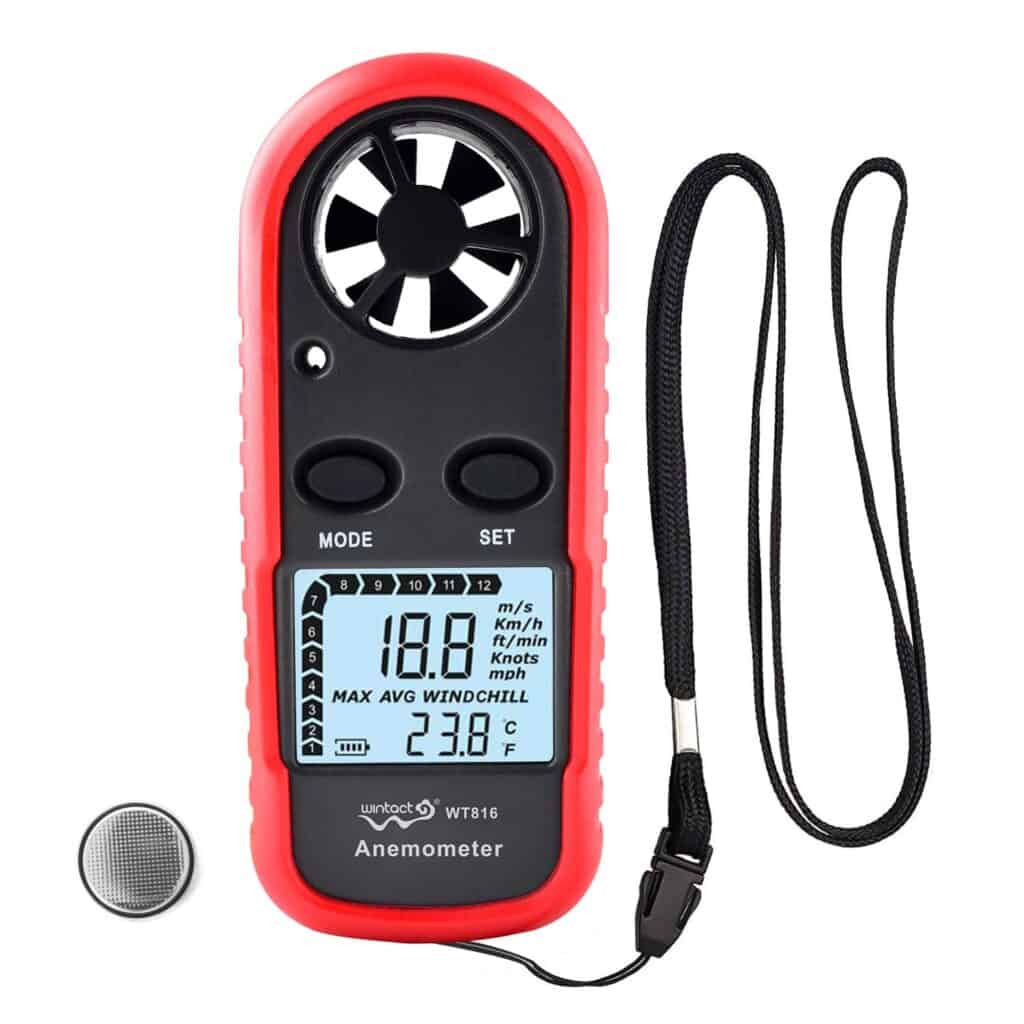
This Wintact Anemometer is a trusty companion for anyone needing quick wind measurements with great pocket-ability.
Pros
Cons
Testing wind conditions has been made effortless with Wintact’s handheld Anemometer. Recently, while sealing my home, I relied on this device to detect the draft sources with precision. Its small stature did not hinder its performance – on the contrary, its portability was a significant advantage as I moved from room to room, assessing airflow and temperature with breeze.
The versatility of this gadget became evident during a windsurfing trip. Despite its unassuming size, it provided instant feedback on wind speeds, helping me make informed decisions about my sail. The display was luminous and legible, even on a sunlit beach, and battery concerns were alleviated by the power-efficient auto-off feature.
However, I did experience some limitations when using this anemometer in extreme conditions. In below-freezing temperatures, the device struggled, a forewarning for winter sports enthusiasts. While in the field, exposure to intense, rugged conditions led to its early demise – a reminder that despite its rugged jacket, it isn’t indestructible. Additionally, the lack of calibration for wind velocity meant accepting readouts as is – not ideal when precision is paramount.
But overall, the pros far outweigh the cons, and my experience has been that the Wintact Anemometer excels in what it’s designed to do – provide quick, accurate wind measurements in a compact, user-friendly package.
AOPUTTRIVER Handheld Anemometer
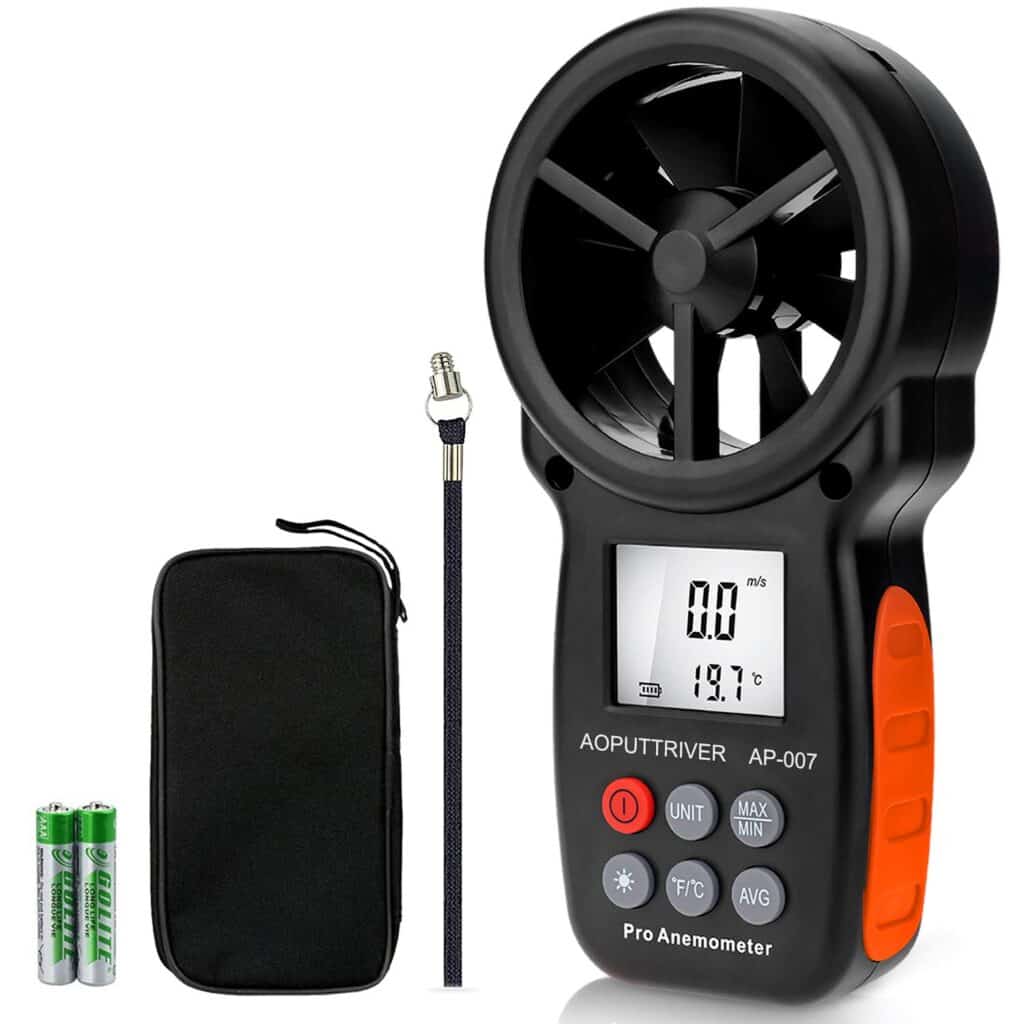
I recommend this device for hobbyists and professionals needing quick and portable wind measurements; it’s versatile and reliable.
Pros
Cons
My recent experience with the AOPUTTRIVER AP-007 Anemometer proved it to be a handy tool for my outdoor activities. Whether flying a kite or gauging wind conditions for drone piloting, the anemometer’s compact and lightweight design made it effortless to carry and use. The multiple units of measurement allowed flexibility depending on the application.
The backlight feature was a lifesaver during dusk when I was wrapping up an outdoor event, and the clear display ensured I caught every important reading without straining my eyes. The auto power-off feature is another thoughtful touch, conserving battery life when the anemometer is accidentally left on.
What stands out most to me is the included small tripod, making it convenient to take continuous readings without needing to hold the device. This proved invaluable when I was setting up for a photoshoot and needed to monitor wind conditions hands-free. However, I did notice the plastic construction isn’t as robust as some other devices I’ve used, so careful handling is advisable. Despite this, the overall functionality for its price range is impressive, and I found it to be a reliable companion for my weather-dependent activities.
Protmex Wind Gauge
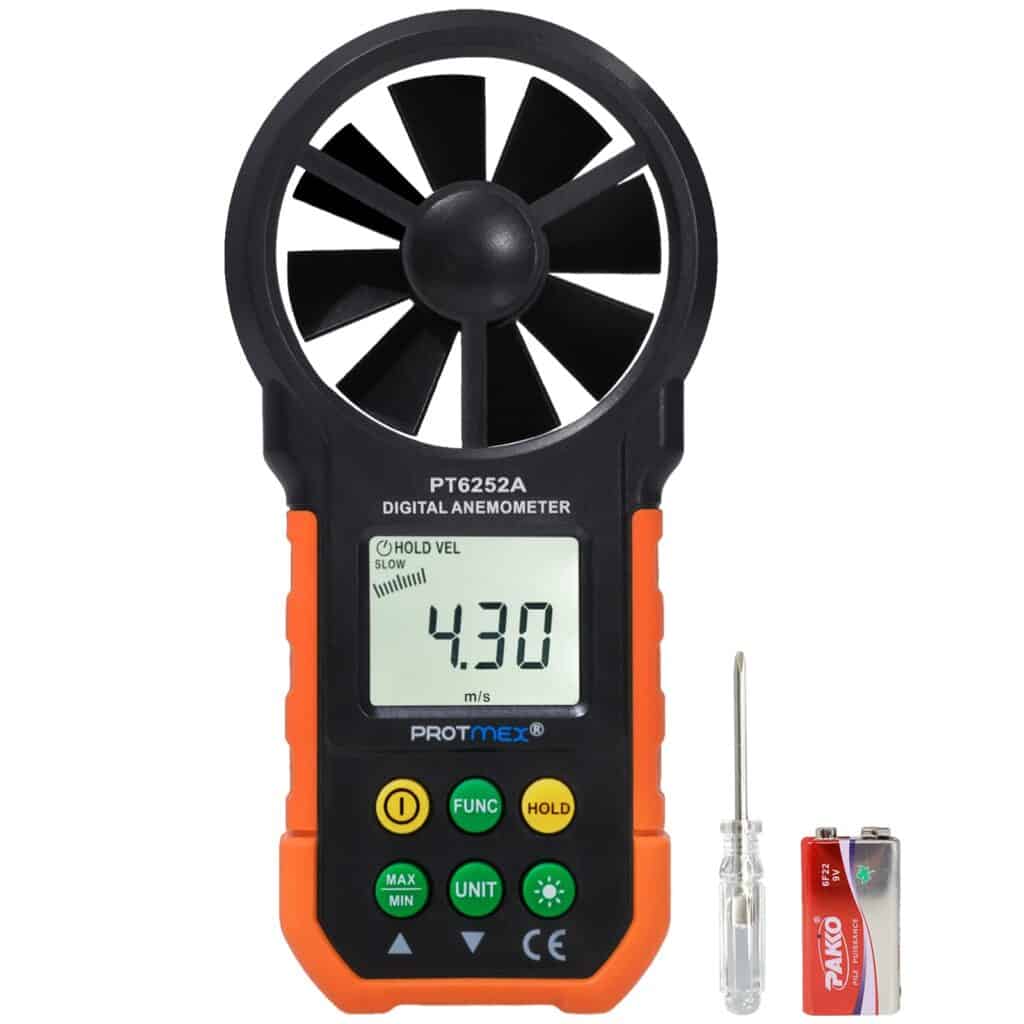
After using this Protmex anemometer, I am confident in its capability to serve both hobbyists and professionals within various activities that require wind measurements.
Pros
Cons
During my time with the Protmex anemometer, I appreciated its accuracy right off the bat – a perfect companion for outdoor activities where wind readings are critical. The assortment of measurement units catered to all my needs, whether I was calculating the right moment to fly my kite or adjusting sails on a boat. Its lightweight, pocket-sized build made it very convenient to carry around.
The ease of use was unmistakable. Unboxing the anemometer, I could immediately navigate through its functions without having to dig through a manual. The manual/auto power-off feature, coupled with the clear backlit display, allowed for quick measurements without fumbling in low-light conditions.
My long-range shooting sessions benefited greatly from this device. Critical adjustments relying on wind readings became less guesswork and more precision. However, as much as the simplicity and functionality impressed me, a part of me wished for a more robust case to shield it against the elements and accidental drops. In addition, I had to stay mindful of the battery life during my extended excursions, though changing them wasn’t much of a hassle.
In conclusion, the Protmex anemometer is a trusty tool that won’t disappoint. It’s got you covered for anything that requires a wind speed check, be it professional HVAC work or recreational drone flying. The absence of a calibration certificate might be a hiccup for the pros, but it doesn’t detract from its overall performance.
AcuRite Notos 3-in-1 Sensor
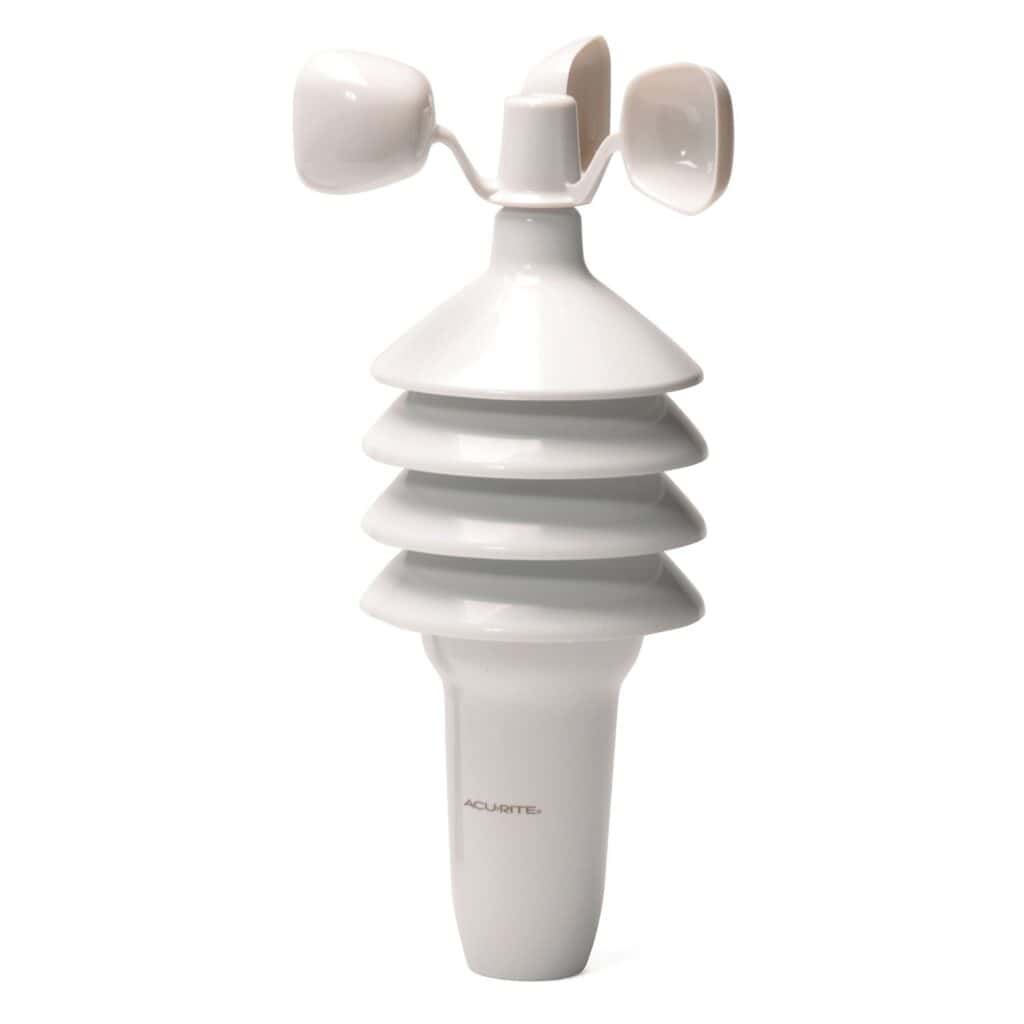
After personally using the AcuRite Notos 3-in-1 Sensor, I find it an excellent choice for anyone needing precise backyard climate measurements.
Pros
Cons
When I first set up my AcuRite Notos 3-in-1 Sensor, I was genuinely impressed with how simple the installation was. The mounting hardware included in the package allowed me to position the sensor securely on my roof in no time. As someone who appreciates convenience, the fact that the sensor transmits data every 18 seconds meant I constantly had fresh insights into what was happening outside, right on my display.
One aspect I noticed during the months of use is the need for a SmartHUB to make the most out of the device’s capabilities. Being able to check the conditions from anywhere on my phone is a feature I didn’t know I needed until I started using the SmartHUB. This kind of connectivity is invaluable for a gardening enthusiast like me, who needs to know precisely when to cover the plants or water them.
The sensor’s precision in detecting even slight changes in wind speed, temperature, and humidity is noteworthy. This precision allows for accurate environmental data, which has proven to be a reliable companion for planning outdoor activities. It’s also interesting to see how the climate changes with the seasons.
The AcuRite Notos 3-in-1 Sensor isn’t just a tool; it’s become an essential part of my daily routine. Whether it’s checking to see if I need a jacket before heading out or optimizing my home’s humidity levels, this sensor provides the data I need. It expertly blends functionality with user-friendliness, making it suitable for both weather enthusiasts and casual users alike.
Invicta 13″ Anemometer
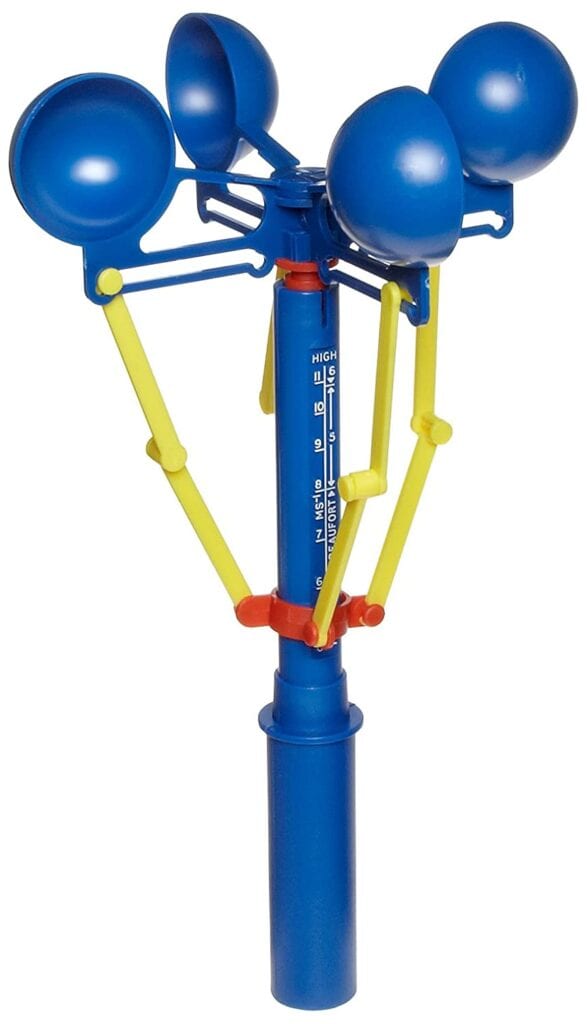
I’ve found the Invicta 13″ Anemometer to be an adequate tool for educational purposes, offering a hands-on experience in measuring wind speeds.
Pros
Cons
In my hands-on experience with the Invicta Anemometer, its utility as a teaching aid became evident immediately. The device offers an intuitive built-in scale for wind speed readings, making it approachable even for young students or weather hobbyists. Moreover, its ability to translate the Beaufort scale is a practical feature, simplifying the understanding of wind speeds in different units.
However, during field tests, the Invicta Anemometer confirmed its limitations outside of the teaching environment. Its plastic build, while lightweight and manageable, raised some concerns about its longevity, especially when used frequently or in less forgiving settings.
Lastly, its classroom-oriented design does comprise sturdy points. Teachers will appreciate the straightforwardness of the Invicta Anemometer for demonstrations. My time with the device underscored its value in an educational context. It effectively bridges the gap between theory and practical application, making it an asset for interactive learning sessions.
Buying Guide
When I choose an anemometer, I consider several key features to ensure accurate and reliable measurements. It is essential to match these features to your specific needs.
Measuring Range and Accuracy
The measuring range is critical; an anemometer should be capable of measuring the wind speeds I expect to encounter. Accuracy is another non-negotiable as it determines the reliability of the readings.
| Feature | Importance |
|---|---|
| Range | High |
| Accuracy | High |
Durability and Build
The construction should withstand the environmental conditions it will be exposed to. A robust build signifies longevity, especially in harsh weather.
| Aspect | Consideration |
|---|---|
| Materials | Must be durable |
| Design | Should protect internal components |
Display and Connectivity
An easy-to-read display and connectivity options enhance usability. I prefer a clear display readout and, if my work requires, the ability to connect to other devices or export data.
| Feature | Preference |
|---|---|
| Display | Clear and legible |
| Connectivity | Versatile options (USB, wireless, etc.) |
Size and Portability
Depending on my usage, I may need a compact and portable device. Ease of carrying and mounting can be crucial for fieldwork.
| Attribute | Desired Quality |
|---|---|
| Size | Compact as possible for portability |
| Portability | Lightweight with easy mounting options |
Additional Features
I look for any additional features that may aid in my tasks, such as backlight for low-light conditions or integrated GPS for location-specific data.
| Extras | Usefulness |
|---|---|
| Backlight | Useful in low light |
| GPS | Beneficial for location tracking |
I evaluate these aspects collectively to select the best-suited anemometer for my requirements.
Frequently Asked Questions
In this section, I provide concise answers to common queries about selecting and using the best anemometers for various purposes. Each question focuses on a specific aspect to help guide you through the decision-making process, ensuring you choose a device that meets your precise needs.
What factors should I consider when choosing an anemometer for home use?
When choosing an anemometer for home use, it’s crucial to consider its ease of installation, durability, accuracy, and whether it has features such as a digital readout or connectivity to smart home systems. The device should ideally be able to withstand local weather conditions.
Which anemometers are recommended for accurate HVAC system testing?
For HVAC system testing, professional-grade vane anemometers or hot-wire anemometers are recommended due to their precision and ability to measure air velocity and temperature accurately. Look for models with calibration certificates for assurance of their accuracy.
What are the top anemometer models for drone pilots to measure wind conditions?
Drone pilots typically favor compact and lightweight anemometers. The top models for this purpose are those that can provide real-time feedback, are easy to use, and have a strong track record of reliability, such as the Kestrel 3500 Wind Meter or the Skywatch Windoo.
How do I select a reliable and accurate anemometer for paragliding?
Selecting an anemometer for paragliding requires one to prioritize portability, durability, and instant read capabilities. A wrist-mounted anemometer like the Flytec Windwatch Pro or a compact handheld unit like the Vaavud Sleipnir is often chosen for these characteristics.
What is the best anemometer to purchase for value and performance?
The best anemometer for value and performance should strike a balance between price and the features offered. The AcuRite 00589 Pro Color Weather Station is often cited for its excellent combination of cost-effectiveness and functionality, making it a popular choice for various users.
What characteristics define the most accurate anemometers available?
The most accurate anemometers are usually characterized by their precise sensors, ability to provide consistent readings across a range of conditions, and calibration to recognized standards. High-end devices like the Kestrel 5500 Weather Meter are known for such attributes.







